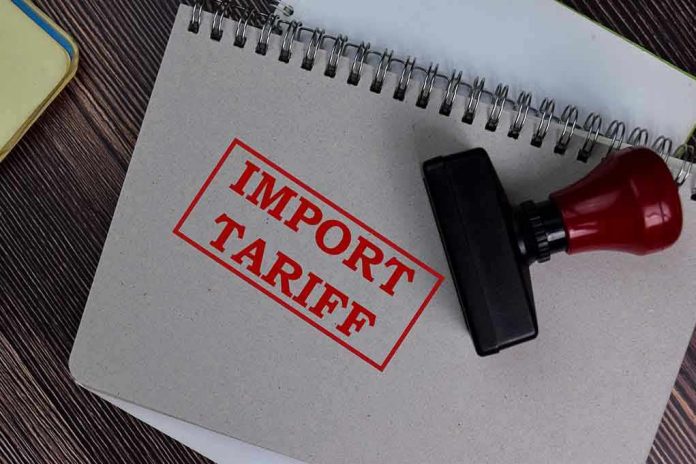
When a single month’s inflation leaps by 3%, and the president blames Canada—yet insists it’s all for America’s own good—the world’s most peaceful border suddenly feels like a front line.
Quick Take
- U.S. inflation spiked 3% in September 2025—directly linked to Trump’s new tariffs on Canadian imports.
- Trump framed the tariff escalation as a fight for fair trade, border security, and drug interdiction.
- Canada struck back with counter-tariffs, then withdrew most except those on strategic sectors.
- Diplomatic relations soured after a Canadian ad campaign led Trump to suspend all negotiations.
Inflation’s September Surge: The Price of Tariffs
September 2025 marked a turning point for American wallets. A 3% inflation spike arrived not as a surprise, but as a direct consequence of a policy decision: President Donald Trump’s aggressive new tariffs on nearly all Canadian imports. These measures, justified in Washington as tools to fix trade deficits, secure the border, and fight fentanyl smuggling, sent shockwaves through both economies. Supply chains stuttered, and consumer goods costs soared—steel, auto parts, even basic groceries became symbols of a broader trade war now felt at every checkout counter.
Canadian retaliation came fast. Prime Minister Mark Carney’s government matched U.S. tariffs with their own suite of countermeasures, targeting American exports with strategic precision. But as September waned, Ottawa blinked—lifting most retaliatory tariffs except on steel, aluminum, and autos. The message: Canada would defend its core industries, but not at the cost of a total trade meltdown. For American businesses, the reprieve was partial and mostly symbolic—by then, price hikes had already filtered through the system, squeezing manufacturers and shoppers alike.
Escalation and Breakdown: From Negotiations to Hostilities
Tariff tit-for-tat first exploded in February, when Trump signed sweeping orders covering nearly all Canadian and Mexican imports. When the first salvo went live in March, Canada wasted no time responding. By midsummer, Trump—citing ongoing trade imbalances and fresh concerns about cross-border crime—raised the stakes again, bumping tariffs to 35%. Canada, careful not to let its economy spiral, scaled back its countermeasures by September, but the truce was fragile at best.
Everything unraveled in October, after a Canadian ad campaign aired footage of Ronald Reagan criticizing protectionism—implicitly shaming the U.S. president’s approach. Trump, reportedly incensed, canceled all trade negotiations with Canada within days. The USMCA, meant to guarantee trade stability, suddenly looked like a paper shield. Businesses on both sides braced for a drawn-out standoff, while policymakers scrambled to reassure nervous investors and the public.
Winners, Losers, and the New Economic Reality
Tariffs, inflation, and political theatrics quickly reshaped North America’s economic landscape. U.S. manufacturers reliant on Canadian steel and components faced cost spikes. Farmers and automakers lost access to stable markets, while Canadian industries reeled from lost U.S. sales. Consumers—already battered by pandemic-era price volatility—now confronted a fresh wave of sticker shock at grocery stores and car dealerships.
Trump’s administration justified the pain as necessary medicine for a “broken system,” promising long-term gains for American workers and families. Conservative commentators echoed the argument, but business groups and economists across the spectrum sounded alarms. Integrated supply chains—decades in the making—don’t rewire overnight. Many warned that the inflationary aftershocks would last far longer than any political advantage gained by “tough on Canada” rhetoric.
Diplomatic Fallout and the Next Front in North American Trade
Diplomatic trust, painstakingly rebuilt through NAFTA and its USMCA successor, frayed with every new round of tariffs and televised insult. Canada’s government, under Carney, began openly courting China and other trade partners, a clear warning shot to Washington that North America’s balance of power could shift. U.S. officials, meanwhile, doubled down on the narrative that tariffs were leverage—not just for economic issues, but for border security and the opioid crisis.
With negotiations suspended and tariffs entrenched in key sectors, the prospect of a quick resolution faded. The real winners, some analysts argued, might be politicians trading on economic nationalism and foreign scapegoats. For businesses and consumers, the price of this new “America First” era is felt every time they open their wallets—and there’s no end in sight. As inflation climbs and alliances shift, the question lingers: how much more economic pain will Americans tolerate for a promise of future prosperity?
Sources:
Wikipedia: 2025 United States trade war with Canada and Mexico
Blakes: U.S.–Canada Tariffs Timeline
Government of Canada: Canada’s response to U.S. tariffs
Fortune: Trump shutting down trade talks with Canada



